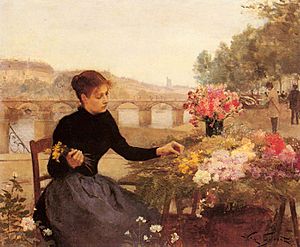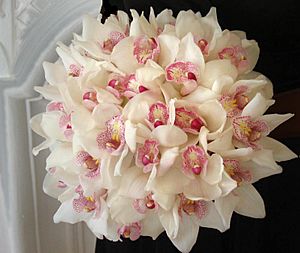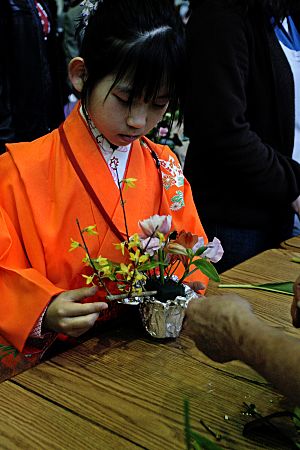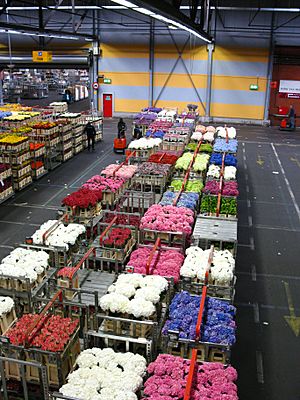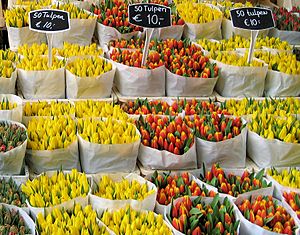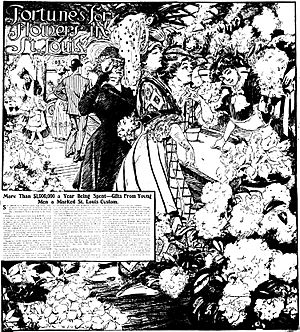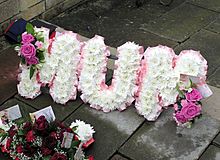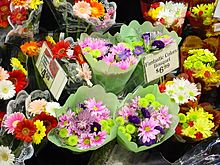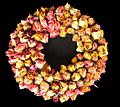Floristry facts for kids
Floristry is all about working with flowers! It's the art and business of growing, arranging, and selling flowers. Think of it as everything that happens to flowers from the moment they are picked until they become a lovely gift or decoration.
People who work with flowers are called florists. They know how to care for flowers, arrange them into beautiful designs, and display them nicely. Florists also deliver flowers for special occasions. Some florists sell flowers in bulk to other businesses (these are called wholesale florists). Others sell fresh flowers and gifts directly to people (these are retail florists). The very first flower shop opened way back in 1875!
Floristry includes growing flowers, arranging them, and selling them. Many flowers used in floristry come from farms that specialize in "cut flowers" – flowers grown specifically to be cut and sold. You can find flowers in florist shops, online stores, supermarkets, garden centers, and even some gas stations!
Contents
What is Floral Design?
Floral design, also known as floral art, is the creative skill of making flower arrangements. This can mean putting flowers in vases, bowls, or baskets. It also includes making bouquets and other designs using cut flowers, leaves, herbs, and ornamental grasses.
Many people use the words "floral design" and "floristry" to mean the same thing. Florists are the people who work with flowers and plants, usually selling them in a shop. Floristry is different from floristics, which is the study of where different plant species grow around the world. It's also different from horticulture, which is the broader study of growing plants.
A good florist knows how to keep flowers fresh for a long time. They also understand what customers want. They can create many types of floral designs, like wreaths, bouquets, corsages (small arrangements worn on clothes), and arrangements for special events.
Learning About Floristry
Many people learn about floristry through classes and workshops. Experienced floral designers teach their skills to students. These students might want to learn floral design as a hobby or as a career. You can often find courses at community colleges, special vocational schools, or through florist trade groups.
In the Netherlands, the first school for growing plants opened in 1896. The first national exams for floristry were held there in 1926. This shows how important formal training became for florists.
Flowers for Special Events
Flowers are a big part of many corporate and social events. They add beauty to special meetings and parties. For example, flowers are used for:
- Table centerpieces
- Decorating entryways
- Reception tables
- Bridal bouquets
- Wedding decorations
- Stage sets
Flowers are also traditionally used in churches and other religious places. Often, skilled volunteers arrange these flowers.
Different Styles of Flower Arranging
Many countries have their own unique ways of arranging flowers. This often depends on the types of flowers available and the culture of the place.
Ikebana: Japanese Flower Art
Ikebana is a special style of floral design that comes from Japan. It is known for its simple lines and shapes. People often practice Ikebana for personal enjoyment. This style uses three main parts to represent heaven, man, and earth. Today, florists in Japan also sell ready-made Ikebana arrangements.
English Garden Style
The English Garden style is a traditional way of arranging flowers from England. Flowers are placed in a circular way, using lots of seasonal flowers and leaves. These designs often look like low, rounded mounds or taller vase arrangements that look good from all sides. They use garden flowers like roses, gardenias, and peonies. The flowers are usually placed close together, with leaves used to highlight them.
Modern/European Style
Modern/European Style floristry uses contemporary, straight-line designs. It focuses on the unique shapes of individual flowers and the overall design. These arrangements often use empty space and place materials in an uneven way. This style is very different from traditional round arrangements like the English Garden style. Modern designs are known for how they use space between flowers and for their bold use of colors and different textures.
Modern/European Style designs often include unique or tropical flowers like Bird of Paradise, Orchids, and Anthuriums. But they can also use more common flowers like roses and lilies.
Contemporary/Dutch Style
Contemporary/Dutch Style designs are also modern and linear. Dutch designs use many different kinds of green plants in a natural way. The "Dutch Garden" style, which started in the 1980s, is a great example. These designs often include natural elements like stones, bark, and mosses.
Meanings of Flowers
Florists usually organize flowers by the season and upcoming holidays.
Flowers can have different meanings in different cultures. For example, poppies are used to remember soldiers only in Great Britain and some other countries. People often choose flowers that are special to their culture or country. The meaning of a flower's color also strongly affects choices. Colors can mean different things, like luck, death, or love.
A red rose might mean love in some cultures, but in others, it might be confusing or even rude. The color white also has very different meanings. In many Asian cultures, white represents death. But in countries with European roots, white usually means purity and innocence.
Where Fresh Flowers Come From
Retail florists usually get their fresh flowers from three main places:
- Local growers (farms nearby)
- Local wholesalers (companies that sell large amounts of flowers to businesses)
- Flower auctions (places where flowers are sold to the highest bidder)
Most of these flowers come from special farms that grow cut flowers.
Around the world, there are many wholesale flower markets and auctions. The biggest one is the Bloemenveiling Aalsmeer in the Netherlands. Other large markets are in Dubai and Tokyo, Japan.
In North America, Miami is a major hub for imported fresh flowers. Many local wholesalers buy flowers from importers in Miami. Large cities like New York, Boston, and Los Angeles also have wholesale flower districts. Flower auctions in Canada, like in Toronto and Montreal, use a special "Dutch clock system" for selling flowers.
Floristry Shops
In the Netherlands, gardeners started selling flower arrangements around 1850. The first "real" flower shops opened around 1900. Back then, these shops often had small greenhouses where they grew some of their own flowers.
A florist's shop usually has many different kinds of flowers. They might be displayed outside or in a large window. To keep flowers fresh, they are refrigerated and kept in water, often in glass or plastic vases. Most shops have a cooler with glass doors near the front so customers can see the flowers easily. Some shops have another cooler in the back for extra flowers and customer orders. Most stores also have a separate workroom where florists can arrange orders with more privacy.
The flowers sold in shops usually include what's in season. But they also have flowers flown in from all over the world. Common flowers include roses, tulips, irises, orchids, and lilies. Fashion can also play a role; what's popular one day might change quickly!
Some shops also sell gift baskets, fruits, and chocolates along with flowers. The flower business changes with the seasons. It's very busy around holidays and events like:
- Christmas
- Valentine's Day
- Mother's Day
- Weddings
- Funerals
These occasions make up a large part of a florist's business. Selling houseplants and home decor is a smaller but more steady part of their sales. Flowers for birthdays, anniversaries, thank-you gifts, and get-well wishes are also a big part of what florists do.
Supermarket Flowers
You can also buy cut flowers in supermarkets and gas stations. These places usually have a smaller selection, often mixed bouquets or roses. Flowers bought here are usually cheaper than those from a florist shop. Professional florists often offer more choices, higher quality flowers, and more skillfully arranged designs.
Technology in Floristry
The number of florist shops in the United States has decreased since the 1990s. The internet has played a role in this change by offering other ways to buy flowers.
"Floral wire services" act as a middleman. They take orders online and then send them to local florists to be made and delivered. These services take a percentage of the order value.
Some companies ship flowers directly to customers. However, many well-known flower companies actually work with local florists to fulfill orders.
Floral foam is a special foam used by florists to hold flower stems in place. It can soak up water, which helps keep arranged flowers fresh for longer.
Images for kids
See also
 In Spanish: Floristería para niños
In Spanish: Floristería para niños


